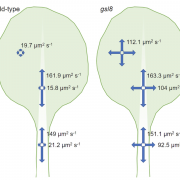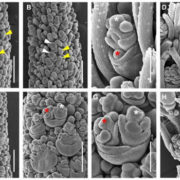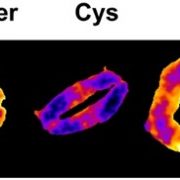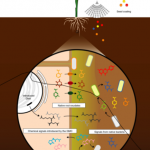An artificial metalloenzyme biosensor can detect ethylene gas in fruits and Arabidopsis leaves (Nature Comms)
 Biosensors have provided abundant information about the distribution of target enzymes, for example auxin, revealing much about their roles in plant physiology and development. Ethylene is a tiny (C2H4) gaseous hormone that hasn’t been very amenable to the development of biosensors. Here, Vong et al. describe the development of an albumin-based artificial metalloenzyme (ArM) that binds a ruthenium metal complex along with a fluorescence molecule and a quencher. In the absence of ethylene, the quencher prevents fluorescence, but in ethylene’s presence the quencher is released and a fluorescence signal formed. This ArM ethylene probe (AEP) fluoresces in the presence of ethylene, as demonstrated in various tissues and in response to pathogens. (Summary by Mary Williams) Nature Comms. 10.1038/s41467-019-13758-2
Biosensors have provided abundant information about the distribution of target enzymes, for example auxin, revealing much about their roles in plant physiology and development. Ethylene is a tiny (C2H4) gaseous hormone that hasn’t been very amenable to the development of biosensors. Here, Vong et al. describe the development of an albumin-based artificial metalloenzyme (ArM) that binds a ruthenium metal complex along with a fluorescence molecule and a quencher. In the absence of ethylene, the quencher prevents fluorescence, but in ethylene’s presence the quencher is released and a fluorescence signal formed. This ArM ethylene probe (AEP) fluoresces in the presence of ethylene, as demonstrated in various tissues and in response to pathogens. (Summary by Mary Williams) Nature Comms. 10.1038/s41467-019-13758-2









